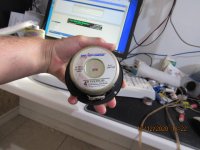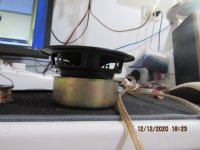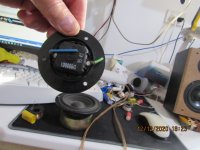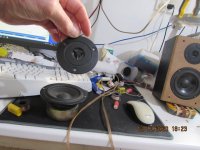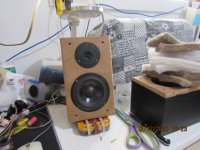Making a small 2-Way for a mate.
Using a couple of roadkill boxes that just happen to have cut outs that fit a small Jaycar woofer and the little tweeter
Audax TW010E1 10mm Polymer Tweeter Review – AmpsLab
The mid needs a small coil in front as the top end is a bit ragged without it but the little Jaycar CW 2104 woofer is quite a good unit
Any point in trying to use a second order XO on this tweeter?
Using a couple of roadkill boxes that just happen to have cut outs that fit a small Jaycar woofer and the little tweeter
Audax TW010E1 10mm Polymer Tweeter Review – AmpsLab
The mid needs a small coil in front as the top end is a bit ragged without it but the little Jaycar CW 2104 woofer is quite a good unit
Any point in trying to use a second order XO on this tweeter?
I think most tweeters need the added protection of a 2nd order (or higher) high pass. But it depends on what the Xover frequency will be.
The TW010 has a tiny voice coil and dome, but it is designed with a surround which makes the radiating surface larger than expected, about as much as as a 20mm tweeter. It does have ferrofluid to help conduct heat away from the voice coil, and from the Audax specification sheet it has a 25W rating with a simple 3uF capacitor. That puts the crossover point at about 6000Hz.
So it comes down to what the xover point will be and how loud you want it to play. Power handling increases to 45W with a 2nd order filter at 6kHz, with a recommended 3.3uF cap and 0.12mH coil (again according to Audax). You could crossover a little bit lower if you don't need the power handling.
The TW010 has a tiny voice coil and dome, but it is designed with a surround which makes the radiating surface larger than expected, about as much as as a 20mm tweeter. It does have ferrofluid to help conduct heat away from the voice coil, and from the Audax specification sheet it has a 25W rating with a simple 3uF capacitor. That puts the crossover point at about 6000Hz.
So it comes down to what the xover point will be and how loud you want it to play. Power handling increases to 45W with a 2nd order filter at 6kHz, with a recommended 3.3uF cap and 0.12mH coil (again according to Audax). You could crossover a little bit lower if you don't need the power handling.
If I could cross lower, about 4k that would be better but I could live with 5k.
It would depend on what I have in the shed, roadkill speakers after all but I'd want them to sound as good as I can get even so.
Won't be for loud and the mates amp is small, about 3o or 40 clean watts
I'll have a play tomorrow nite
Thanx
It would depend on what I have in the shed, roadkill speakers after all but I'd want them to sound as good as I can get even so.
Won't be for loud and the mates amp is small, about 3o or 40 clean watts
I'll have a play tomorrow nite
Thanx
I think taking out the midrange breakup region is a good reason to use the higher order, otherwise you want to cross lower. So this has a double effect in improving tweeter power handling.
On the other hand the higher order is harder to make sound good when you don't measure.
On the other hand the higher order is harder to make sound good when you don't measure.
This tweeter also has a fairly high Fs, at 3kHz. The rolloff slope below Fs approximates a 2nd order filter. It also has more excursion capacity designed into it, xmax of 0.25mm, actually way above a typical tweeter.
A 2nd order filter at 4k, operating close to Fs, will acoustically be more like a 4th order filter. Excursion requirements increase rapidly as frequency decreases. It is an inverse-square relationship, so 4kHz needs 2.25 times the movement of 6kHz for the same SPL. Excursion and voltage are directly related, so to be "safe" at 4kHz you should only apply 1/2.25 the voltage that is safe at 6kHz. This implies that the power rating with a 4kHz xover should be 8W instead of 40W. But you would gain a little more margin because the actual rolloff is more like 4th order, not 2nd order. In this particular application that may be enough.
A 2nd order filter at 4k, operating close to Fs, will acoustically be more like a 4th order filter. Excursion requirements increase rapidly as frequency decreases. It is an inverse-square relationship, so 4kHz needs 2.25 times the movement of 6kHz for the same SPL. Excursion and voltage are directly related, so to be "safe" at 4kHz you should only apply 1/2.25 the voltage that is safe at 6kHz. This implies that the power rating with a 4kHz xover should be 8W instead of 40W. But you would gain a little more margin because the actual rolloff is more like 4th order, not 2nd order. In this particular application that may be enough.
I had in my car the one with the golded platetd dome... close enough. Audax advised a second order when I get the kit with the areogel midwoof... the tweeter sounded good. I don't remember which was the cut-off but have a look on Ampslab site : some design are shown with this tweeter. TW010E1 – AmpsLab
My personal experience of these 10mm formerless mylar tweeters is that they are much more like a 1 inch cone tweeter, with 10mm dustcap.
The acoustic lens is there for a reason, I once removed it, and it was not an improvement!
Also, besides the high Fs, the the audibility of the Fs resonance is such that I never found even 2uF first order sufficient. These need at least 2nd orders and high enough above 3k...probably 6k or more, for that resonance to not be audible, and the tweeter equivalent of reflex bass boom - one note, one timbre treble.
Awful things.
The acoustic lens is there for a reason, I once removed it, and it was not an improvement!
Also, besides the high Fs, the the audibility of the Fs resonance is such that I never found even 2uF first order sufficient. These need at least 2nd orders and high enough above 3k...probably 6k or more, for that resonance to not be audible, and the tweeter equivalent of reflex bass boom - one note, one timbre treble.
Awful things.
I remember working with these tweeters in the mid 1980's. They were about $5 back then, and low cost was their main feature. I never heard a system employing these that I really liked. Stepping up to a real dome tweeter, even an inexpensive one, was a big improvement. There were Audax and Peerless polyester and polyamide textile dome tweeters that were in the $15 to $20 range, and these were imensely better.
I think I paid about $5- myself.
I agree that they are not the best but these are roadkill speakers, and I reckon a $0.55- cap goes reasonably with a $5- driver
I agree that they are not the best but these are roadkill speakers, and I reckon a $0.55- cap goes reasonably with a $5- driver
My personal experience of these 10mm formerless mylar tweeters is that they are much more like a 1 inch cone tweeter, with 10mm dustcap.
The acoustic lens is there for a reason, I once removed it, and it was not an improvement!
Also, besides the high Fs, the the audibility of the Fs resonance is such that I never found even 2uF first order sufficient. These need at least 2nd orders and high enough above 3k...probably 6k or more, for that resonance to not be audible, and the tweeter equivalent of reflex bass boom - one note, one timbre treble.
Awful things.
Interesting.
The spec sheet data does seem to resemble a very small cone rather than a dome. That would would explain it having any significant Xmax at all. Most cheap domes have Xmax of zero (when they bother to provide that data at all), the voice coil height equals the magnetic gap height.
"Hard" domes, metallic, polycarbonate, mylar, do tend to have ringing which must be dealt with if it falls in the audible range. The central obstruction of the "acoustic lens" probably is intended to block some of the on-axis high frequency ringing above 10kHz. I doubt it would have any effect at the longer wavelength at 3kHz, but perhaps it also provides some small amount loading which reduces excessive excursion at Fs.
The Ampslab review was surprisingly positive.
Playing now. Wendy Mathews "Cafe Naturale"
Now these won't win any prizes but they are inoffensive and play louder than my beloved partner can tolerate.
Cheap 0.33mH coil on the woofer and 2uF on the tweeter with a 0.1mH shunt to ground on the tweeter and no padding.They sound better with my hearing aids in and turned on. Most of the music is coming from the 100mm woofer naturally.
Using because they fit the cut-outs in the road kill boxes.
Wood is OK but when I got these the drivers were RS
Now these won't win any prizes but they are inoffensive and play louder than my beloved partner can tolerate.
Cheap 0.33mH coil on the woofer and 2uF on the tweeter with a 0.1mH shunt to ground on the tweeter and no padding.They sound better with my hearing aids in and turned on. Most of the music is coming from the 100mm woofer naturally.
Using because they fit the cut-outs in the road kill boxes.
Wood is OK but when I got these the drivers were RS
Attachments
Interesting.
The spec sheet data does seem to resemble a very small cone rather than a dome.
It's very easy to test. The faceplate just screws off, attached bayonet style.
The dome "surround" is at least as large as the dome itself.
It's a cheap (the cheapest) Audax dome, ever made, albeit using some interesting technical features. It's a bit of a shame that they were not as high end, as some of the manufacturing tech used.
All I can say, I I would describe then as having a very high Q resonance sound.
In the UK these tweeters were used on Gale loudspeakers, absolutely bargain basement £60 a pair bookshelves through to budget Wharfedales - not to sound like a snob, but they all sounded dire.
I'd guess they could be used well, as a super tweeter, at say 9k and up, with a full range driver. They were kind of comparable to the cheapest Motorola Piezo cone tweeters of the time (1.75" IIRC), and they cost about £5, back in 1995 or so, when even midrange (and still a bit poor) Audax 1" domes cost, 4 times the price
However, something like Audax TW025F1, of which I have a pair (thanks to P10) are much more natural sounding, and also small faceplate designs, still a high ish Fs, but infinitely more usuable, and satisfying. Also cheap.
These were paired with both the paper and HDA 5" drivers if that era (HM130MO and AP130ZO, of I recall p/n correctly)
Last edited:
- Home
- Loudspeakers
- Multi-Way
- Audax mylar tweeters
